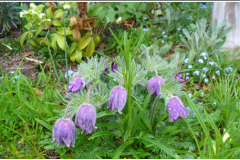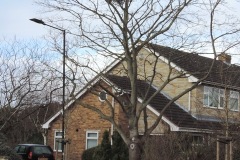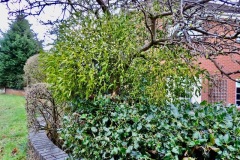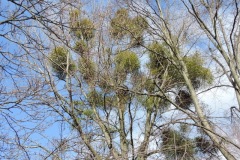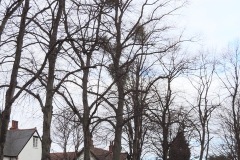Figure 1. Pasque-flowers in the garden of Elizabeth Farningham, Hallam Close, Bessacarr. Spring 2011 (Photo by C.A. Howes).
Though a popular subject with domestic gardeners (see Figure 1), the Flora Britannica laments that the Pasque-flower Pulsatilla vulgaris in the wild is now a nationally scarce plant. “Its largest colony is on the steep banks of Barnsley Warren in the Cotswolds, the smallest, probably the few flower that cling on in short turf on the Magnesian Limestone in West Yorkshire – its most northerly station in Britain” (Mabey, 1996).
Even by the time the 19th century botanists were compiling their local and regional floras, this visually striking plant was almost a distant memory in the wild.
To provide a historical background to current endeavours to restore this stunningly attractive but vulnerable plant to its former sites within the Doncaster landscape, this study attempts to collate information from what are now obscure literature sources and herbarium collections.
The most northerly surviving British locality “is one location in short turf on the Magnesian Limestone [in VC64] where a tiny population has been known for several years and is still present” (Lavin & Wilmore, 1994). Attempts have been made to increase the population by bringing pollen from another British site but without success due to damage by rabbits (Abbott, 2005).
Within West Yorkshire [VC63] F.A. Lees (1888) describes its former distribution as in “dry grassy turf of the Permian Limestone-tract ridge. From S. to N. of our area” where it was “once common” but is “now almost extinct”.
Within South Yorkshire, the species is “now presumed extinct in the county”, having been lost almost certainly through agricultural improvement in the 19th century and later (Wilmore, et al 2011).
Sites in or adjacent to the City of Doncaster Metropolitan Borough
Smeaton Crags – Edwin Lankester (1842) knew it at Smeaton Crags, where T.W. Gissing (1865 & 1867) noted “This rare and beautiful plant is fast disappearing from this the only locality [in the Wakefield district] in which it has been seen in flower for the past five years [1860-65]”. Lees (1888) visited the site in 1870 and confirmed the plant’s continued presence.
Permian Limestone east of Rotherham – Since Larret Langley’s (1828) Flora referred to sites within a radius of 8 miles from Rotherham, the species’ presence on the Limestone east of Rotherham could refer to sites in the vicinity of the villages of Braithwell, Micklebring and Clifton.
Scawsby Leys/Pickburn Leys – In The Botanist’s Guide (Turner & Dillwyn, 1805) a record of Pasque-flower had been communicated by the Rev. Archdeacon Robert Pierson in 1798 from “a heath between Doncaster and Brodsworth”. Henry Baines (1840) in the Flora of Yorkshire also recorded Pasque-flower from the same heath but gives no source, indicating it to be his own record. This is confirmed by Graeme Coles (2011) who located a herbarium sheet in the collection of the Yorks. Phil. Soc. in the Yorkshire Museum, with plants collected from this site by Baines in 1838. Lees (1888) interpreted the site description as referring to Scawsby Leys and Coles (2011) judged the record to represent the first for South Yorkshire. The Ordnance Survey interpretation of Scawsby Leas places it adjacent to the Roman Ridge public footpath where it takes up most of SE5305, sadly now intensively arable. However, George Roberts (1882) quotes late 18th century botanical annotations by David Dixon in Joseph Wilcock’s copy of John Berkhout’s Synopsis of the Natural History of Great Britain and Ireland. Tantalizingly these annotations include a reference to Pulsatilla vulgaris ‘at its Pickburn site’ dating from 1799. Pickburn Leys, owned by the Thellusson family of Brodsworth Hall and therefor part of the Brodsworth estate, is also adjacent to the botanically rich Roman Ridge and occupies much of SE5206 and SE5306. Here, the historic maps show the flat landscape on the crest of the Limestone ridge, was managed through much of the 19th century as a racecourse and equestrian training ground. It would therefore have been under permanent grassland and may well have been the site variously described as ‘a heath between Doncaster and Brodsworth’, ‘Scawsby Leys’ and ‘Pickburn’. Subsequent usages have included limestone quarrying, the site of Brodsworth colliery with associated waste tips and mineral railway sidings and today the restored landscape and Brodsworth Community woodland.
It is appropriate that some of the most spectacular shows of horticulturally managed Pasque-flowers in the region are in the English Heritage gardens on the Permian limestone at Brodsworth Hall.
Herbarium specimens – Examples located to date from the Yorkshire Permian limestone ridge are two undated sheets from Wetherby, South East of Thorpe Arch (VC64) collected by Elizabeth Lomax and Charles Bailey (Manchester University Herbarium); Ackworth (VC63) collected in 1855 by E.F. Forbes, James Ward and George Stephen (Birmingham University Herbaruim); and a sheet containing plants from a heath between Doncaster and Brodsworth (VC63) collected 1838 by Henry Baines (Yorkshire Philosophical Society Herbarium at The Yorkshire Museum, York).
Literature references
Abbott, P.P. (2005) Plant Atlas of Mid-west Yorkshire. Yorkshire Naturalists’ Union, Leeds.
Baines, H. (1840) The Flora of Yorkshire. London.
Coles, G.L.D. (2011) The Story of South Yorkshire Botany. Yorkshire Naturalists’ Union, Leeds.
Gissing, T.W. (1865) Materials for the Flora of Wakefield. The Naturalist 2: [15 articles between] pp.6 and 295.
Gissing, T.W. (1867) Materials for the Flora of Wakefield and neighbourhood. London & Huddersfield.
Howes, C.A. (1986) Doncaster district plant records from T. W. Gissing’s ‘Flora of Wakefield’. The Doncaster Naturalist 1 (7): 189-191.
Lankester, E. (1842) An Account of Askern and its mineral springs together with a sketch of the Natural History and a brief Topography of the immediate neighbourhood. John Churchill, London.
Langley, L. (1828) Flora of Rotherham. Lond. Mag. Nat. Hist. 2: 269-270.
Lees, F.A. (1888) The Flora of West Yorkshire. Vol. II of the Botanical Series of the Transactions of the Yorkshire Naturalists’ Union. Lovell Reeve & Co., London.
Lavin, J.C. & Wilmore, G.T.D. (1994) The West Yorkshire Plant Atlas. City of Bradford Metropolitan Council, Bradford.
Roberts, G. (1882) Topography and Natural History of Lofthouse and its Neighbourhood. Richard Jackson, Leeds.
Turner, D. ad Dillwyn, L.W, (1805) The Botanist’s Guide through England and Wales. London.
Wilmore, G.T.D., Lunn, J. and Rodwell, J.S. (2011) The South Yorkshire Plant Atlas. Yorkshire Naturalists’ Union & Yorkshire & the Humber Ecological Data Trust, York.
Colin Howes
Following up on the current interest in local Mistletoe distribution, comments made by Carol Benson and Louise Hill at the Doncaster Naturalists’ Society AGM, led to CAH making visits to West Bessacarr to count extant clumps of this seldom recorded plant … seldom recorded, yet so obvious during the winter months when deciduous trees have lost their leaves.
The Oval
Two large growths of Mistletoe at the entrance to The Oval, off Bawtry Road (A638) (SE/601023) had featured in the original (2004/05) Doncaster Naturalists’ survey. One had been on a tall Lime tree (Tilia x europaea) in the garden of the first property on the north side of the road and the other on what was thought to have been an Apple tree (Malus domestica) in the same garden. They were first noted in early March and 4 April 2005 (pers comm C. Howes & G. Bennett) and mentioned in Howes (2008). Last recorded in 2019 by Geoff Carreck, they seemed to have disappeared during the intervening years, so it was decided to investigate further.
On 22 February 2023 it was found that although the original clump on the Lime tree had been removed, there was a small sprig of mistletoe growth remaining on the tree. The adjacent ‘Apple tree’ seemed to have been removed. However, in proceeding to adjacent properties, on the north side, two tall Lime trees in front gardens were found to be hosting 2 clumps and I clump respectively.
Since all previous observations had been made while passing along Bawtry Road on bus, bicycle, car or indeed on foot, it was only the initial two clumps that ever received notice. It was therefore astonishing to encounter the vista within the Oval itself. Of the 27 very tall Lime trees planted around the circumference of the Oval’s central green-space (SE/600 022), five sported conspicuous mistletoe growths in their lofty crowns. A preliminary count showed trees with 9, 7, 6. 2 and 1 clumps respectively. This aggregation of 25 clumps formed the largest population come across to date in the Doncaster region. However, populations in the adjacent St Augustine’s Road to the south and nearby Booth Avenue to the north, both visible from the Oval, and the more distant clump in Middlefield Road, represent a significant but previously unappreciated West Bessacarr meta-population. Another, though late, member of this meta-population was the mistletoe clump in what was thought to be a Poplar at the Gliwice Way entrance to the Dome Leisure Centre. This had been spotted by Ian Mcdonald on 16 February 2018 but felled (!) by the DMBC two weeks later.
Booth Avenue (SE599 024) leading to the Campanile Hotel & Restaurant and the Salvation Army Citadel. While travelling as a passenger along Bawtry Road, Louise Hill was excited to see a previously missed ‘congregation’ of mistletoe clumps in a row of lofty hybrid Poplars (Populus spp). Of these ten trees, planted along the boundary with the adjacent electricity substation, five had a total of 6 mistletoe bunches high in their canopies. Numbers from east to west were 1, 2, 1, 1, and 1 respectively (surveyed by CAH 21 February 2023).
St Augustine’s Road (SE/601 021)
As mentioned above, a tree of unknown species supporting a considerable number of fine, spherical growths of mistletoe was seen to the rear (south) of properties on The Oval. On visiting St Augustine’s Road on 22 February the tree was found to be in a walled garden which seemed not to have any access from the St Augustine’s side. Peering over the high wall the colony proved to be remarkable, consisting of at least 40 large, often merging mistletoe bunches. This was undoubtedly the largest single colony yet encountered, with at least three adjacent trees (one a Sycamore Acer pseudoplatanus) having 2, 1 and 1 Mistletoe clumps respectively.
Middlefield Road
Further south along Bawtry Road, there is “Quite a fine specimen” in a tree near the top of Middlefield Road. This was first commented on by Geoff Carreck on 25 January 2022 and also reported by Carol Benson at the Nats Committee meeting (February 2023). The Host tree, a Sycamore, is indeed in the garden of the first property on Middlefield Road (SE/SE609 012) and the Mistletoe is indeed “a fine specimen”. However, While Nora was photographing this specimen on 26 February,
I blundered into a fine fruiting female colony at chest height blending into the topiaried contours of a shrub (possibly a Prunus sp.) in the front garden the flats opposite (nos. 116 and 118).
As far as we can tell, the West Bessacarr meta-population consists of at least 84 clumps on 21 host trees, mainly Limes, Poplars and Sycamore, extending for approximately 1.5km from the Leisure Dome to Middlefield Road along the Sherwood Sandstone ridge on the west side and parallel to the A638 Bawtry Road. Any additional records, particularly from the mature gardens on the east side of Bawtry Road would be welcome.
It is possible that the specimens further south in Rossington [Station Road (SK/622983) and Beech Road (SK/622976)] and the historical records at Hesley Park (SK/6195), may be part of the same population and by implication could warrant searches and enquiries being made further south in the Bawtry district.
We have found that populations hide in clear sight and often masquerade as dome shaped Magpie (Pica pica) nests and spherical squirrel (Sciurus carolinensis) dreys.
In reading accounts of the previous national (BSBI and Plant Life) surveys, it looks like input from the Doncaster region has been consistently ignored. Certainly in the resultant distribution maps (see Jonathan Briggs 2021), even the current NBN interactive distribution map, Doncaster is erroneously shown as a ‘blank canvass’!
Acknowledgements
Thanks are due to Nora Boyle for making a photographic record of these specimens on 26 February 2023 and checking out their OS grid references via an app on her iphone.
References:
Briggs, J. (2021) Mistletoe, Viscum album (Santalaceae), in Britain and Ireland: a discussion and review of current status and trends. British & Irish Botany 3(4): 419-454.
A Doncaster Mistletoe Survey: Background notes.
On 11 January Francis Hickenbottom opened the 2023 season of indoor meetings for the Doncaster Naturalists’ Society with his spirited and inspirational illustrated talk ‘Dead Flies and other fascinating Things!‘. Amongst a cavalcade of fascinating themes, his talk included a sequence of photographs illustrating the curious germination of Mistletoe berries and their haustorial insertion into their woody host plants.
This reminded me that some years ago the Doncaster Naturalists’ undertook a survey of Mistletoe plants and their host trees in the Doncaster district. The project was conducted by Dorothy Bramley as part of a national survey and Nats members kept their beady eyes open for local examples of this scarce and mysterious plant.
The project was publicised by Pip Seccombe (2005) who canvassed readers of the Doncaster Star for their observations. Finally, the records were collated and sent off to the national project (possibly organised by the BSBI). Unfortunately, in preparing to transfer records to the local database it was realised that a copy of our list hadn’t been retained (!). This possibly explains why the distribution map for Mistletoe in the South Yorkshire Plant Atlas (Wilmore, et. al. 2011) only shows a single solitary dot for Doncaster.
It occurred to me that while trees are minus their leafy canopies, we should re-run our survey for the evergreen clumps of Mistletoe.
The following modest scatter of historical records are collated to form a background to the project.
Henry Baines (1840) in The Flora of Yorkshire, ambiguously reported that Mistletoe occurred “… not very unfrequently … in woods and orchards in the Vale of York”. With Doncaster situated in the southern Vale of York, this comment marginally referred to us. Indeed, an examination of the series of 1:2500 OS sheets for the Doncaster district for the 1930s shows the former abundance of local orchards. Since Mistletoe was traditionally/commercially infected onto managed apple trees, green swags of this evergreen plant may indeed have been a familiar local sight in former times.
For specific 19th century records, Mistletoe was known to occur on Askern Common (SE/51) (Lankester, 1842) and near Adwick-le-Street (SE/50) per W.W. Newbold (Lees, 1888).
For passengers on the LNER London to Edinburgh railway line, opened during the 1840s, publications provided information on places and topographical features of interest to look out for during the journey. In 1912 The Yorkshire Observer encouraged passengers on the Doncaster portion of their journey to look out Mistletoe in trees of Poplar, Hawthorn, Apple and Cockspurthorn (Crataegus crus-galli) in Hesley Park (SK/6195), south of Rossington. This story was picked up by Dallman (1934), Howitt & Howitt (1963) and Howes (1989 & 2008).
From a long lost and digitally antique (2005) Microsoft Write file compiled by Pip Seccombe and salvaged by Bob Marsh, the following records have been retrieved:
Following the appeal in the Doncaster Star (Seccombe, 2005), members of the public and Doncaster Nats members provided the following anecdotes:
2004
Beech Road, Rossington (SK/622976) On tree in back garden.
22, Norwich Road, Wheatley Park (SE/5905) A massive bunch on a Granny Smith apple tree which was ‘planted’ 8 or 9 years ago and is thriving but doesn’t produce berries. Another one which was planted at the same time, was broken when pruning the tree, while still a small twig and didn’t come back. (pers comm Bill Telford)
Sandrinham Road, Intake (SE/5903) A once healthy plant growing in a front garden on a tree stump, failed to appear about 2 years ago. Maybe it couldn’t compete with the ivy which now covers the stump (pers comm Bessie Chapman).
Sprotbtough Road (SE/5502) A small sprig which appeared on Sprotbrough Road last year has been broken off and failed to re-appear. (pers comm Bob Marsh’s daughter).
Auckley Common Lane (SE/6501). Many years Mistletoe berries and their gelatinous contents were smeared onto some orchard apple trees. It was 3 or 4 years later that sprigs of mistletoe appearing on 2 of the trees. One snapped off while still small, but the other tree now has 3 or 4 pieces of healthy mistletoe, the largest of which is about 1 square yard. This year (2004) sprigs were cut to take to the Hospice. None of these plants had produced berries (pers comm Mrs Gilligan).
2005
Station Road, Rossington (SK/622983). Mistletoe on tall street tree, possibly Lime, opposite Police Station in Jan 2005 (pers comm C. Howes). Identity confirmed and photograph taken in February 2005 (pers comm Thelma Dove).
The Oval, Bessacarr (SE/601023) Large Mistletoe growing on a Lime tree facing west at the Bawtry Road end of the Oval. The tree is overhanging from the first garden on the north side of the road. There is also a large colony of mistletoe on an ?Apple tree overhanging the boundary of the same garden but a few yards to the west of the Lime. First recorded in late March 2005 (pers comm C. Howes & G. Bennett).
Launch of a new survey
Last Thursday (26 January 2023) Nora, Hillary and I spotted two splendid Mistletoe bunches in the crown of a roadside Lime tree opposite the police station on Station Road, Rossington (SK/622983). Probably the same plants as were recorded 18 years earlier by CAH and Thelma Dove.
Let’s keep our eyes peeled for evergreen clumps of Mistletoe in the canopies of trees in woods and gardens before the spring foliage masks out the evidence. Also ask around, it’s surprising how many people know of traditional colonies and some may even have attempted to propagate Mistletoe in their own gardens.
Any records and photographs would be gratefully welcomed.
Contact: Colinhowes@blueyonder.co.uk or Louise.a.hill@googlemail.com
References
Anon. (1912) Out of Doors. The Yorkshire Observer. 18 December 1912.
Baines, H. (1840) The Flora of Yorkshire. London.
Dallman, A.A. (1934) Viscum album L, in Nottinghanshire [now South Yorkshire]
North Western Naturalist 9: 384-385.
Howes, C. (1989) Bessacar & Cantley Times (November 1989) no. 2 and
(December 2008) no. 197 p. 64-65.
Howitt, R.C.L. & Howitt, B.M. (1963) A Flora of Nottinghamshire. Published privately
(p. 169).
Lankester, E. (1842) An account of Askern and its Mineral Springs together with a
sketch of the Natural History and a brief Topography of the Immediate
Neighbourhood. John Churchill, London.
Lees, F.A. (1888) The Flora of West Yorkshire. Lovell Reeve & Co., London as
Botanical Series of the Transactions of the Yorkshire Naturalists’ Union
(p. 266).
Seccombe, P. (2005) Appeal for Mistletoe records in the Doncaster area.
The Doncaster Star. December 2005.
Wilmore, G.T.D., Lunn, J., and Rodwell, J.S. (2011) The South Yorkshire Plant Atlas.
Yorkshire Naturalists’ Union & Yorkshire & Humber Ecological Data Trust.,
York. [see map 424 showing 8 South Yorkshire sites, 7 in the Rotherham
Metropolitan Borough and just 1 in the Doncaster Metropolitan Borough].
